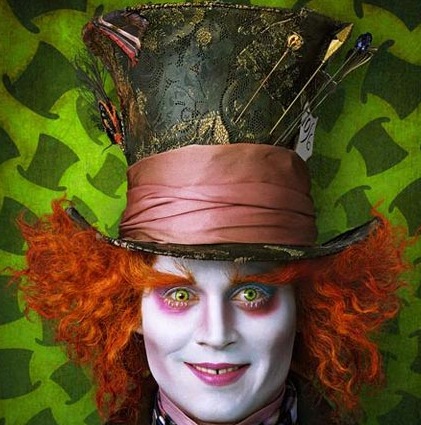8.24.2010
Essay: Tim Burton in Blunderland - An Addendum
After writing about Tim Burton a week or so ago, I felt obliged to see his Alice in Wonderland from earlier this year despite extremely low expectations, if only because it’s the only film of Burton’s that I had not yet seen. As I said, my expectations were already buried so deep they were treading water – and yet, amazingly, they were not met.
Burton’s version of Alice isn’t so much “re-imagined” as it is ground up into disgusting, incoherent chunks which are then lobbed indiscriminately at an unsuspecting and malnourished audience. Despite a very shaky decade of work, Burton’s films up to this point have at least reflected the director’s unique adherence to bizarre and often beautiful design work. But Alice is Burton’s first downright ugly film, with a color scheme that looks like a kindergarten classroom minus the fun and sense of possiblity. The hideous CGI work saps the scenery of appeal and personality, which is especially regrettable given that Burton’s reputation was originally built upon a hand-crafted style that favored miniatures and stop-motion.
Strangely, there are cameo appearances by the twisted tree and windmill from Sleepy Hollow – one of Burton’s best visual achievements and dullest stories. It’s as if they were included here to remind you of who directed the film, because there is almost no other evidence of Burton’s involvement. The CGI environments of Alice are slapdash and phony – colder and less imaginative than those of Avatar, a film I don’t admire but enjoyed more than this hash. The look of Alice is further proof that Burton’s work on the film could only have been in the capacity of hired gun, no doubt receiving a hefty paycheck from Disney to churn out a new version of a very old studio-owned property.
The story represents a wholly unnecessary diversion from the source novels by Lewis Carroll. The script takes a weird turn and casts an older Alice as some kind of amnesiac who has forgotten her earlier trip down the rabbit hole, and now finds herself back in “Underland” trying to defeat the Red Queen. The total effect is incoherence, as the script recycles Carroll’s material in a way that parallels the original story without exactly replicating it. It’s a confusing choice, without logic, that renders Carroll’s wonderful work inert.
As Alice, newcomer Mia Wasikowska holds her own against an onslaught of mostly invisible co-stars. She’s lovely and talented, yet somehow miscast. Perhaps she’s too lovely for the part – and not scrappy enough? I’m not sure. Wasikowska is good in the role, but without being right for it.
Johnny Depp plays the Mad Hatter as another in a series of roles that call for the actor to cast aside a large part of his considerable talent and play a mannered buffoon. Sometimes he’s quite good at this – especially when the script calls for it. But Alice’s script is poor to begin with, and his role in particular bears evidence of artificial “enhancement” for the sake of its star.
The only thing reminding us that we are in Burton country is Danny Elfman, whose score is dependably pleasant if not revolutionary. The quality Elfman’s score is all the more interesting for having been inspired by such a terrible film.
And in the end, that’s all it is: terrible. Devoid even of the merest flashes of creativity, Tim Burton’s Alice in Wonderland has made me reconsider the “appeal” portion of my earlier post. Instead of trusting in his own storytelling instincts, I think Tim Burton should take a hard look at what he has been producing. Certainly, he can’t need more money. And I find it hard to believe that he simply "enjoys working" – especially since he’s one of the few directors who have the kind of pull to get their own projects off the ground. Maybe Burton needs to take a break – there’s no doubt that I need one from him.
Labels:
essay,
movie reviews
Subscribe to:
Post Comments (Atom)





No comments:
Post a Comment